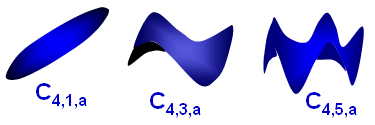=================================================================================
In aberration correctors, multipole aberration corrections produce electron beam distortions of well-defined angular exponent and azimuthal symmetry because the inaccuracies of EM (electron microscope) construction practically prevent from ideal performance, and even a perfect EM system may experience changes of mechanical, electrical and materials properties after the construction. For instance, Nion quadrupole-octupole 3rd order corrector [1] introduces beam distortions consisting of 1st and 3rd order, 2-fold and 4-fold symmetry.[2, 3] Therefore, parasitic aberrations, not depending on the fundamental symmetries of the manufactured EM systems can essentially limit the corrector performance at any order or azimuthal symmetry. In the quadrupole-octupole systems, parasitic aberrations normally include sextupole-like 4th order types, having 1-, 3-, and 5-fold symmetries (aberration coefficients C4,1,a, C4,1,b, C4,3,a, C4,3,b, C4,5,a, and C4,5,b), which are highlighted in green in Table 3650 and are indicated by the examples in Figure 3650.
Table 3650. Aberration Coefficient Nomenclature. The aberration coefficients have two
main types of notations, namely Krivanek notation, and Typke and Dierksen notation.
| Krivanek notation |
Typke and Dierksen notation |
Radial Order |
Azimuthal Symmetry |
Nomenclature |
| Ray |
Wave (k) |
| C0,1 |
A0 |
0 |
1 |
1 |
Image Shift |
| C1,2 |
A1 |
1 |
2 |
2 |
Two-fold axial astigmatism (or axial astigmatism of the 1st order) |
| C1,0 |
C1 |
1 |
2 |
0, ∞ |
Defocus (overfocus positive, or spherical aberration of the 1st order; Real numbers and describing rotationally symmetric contributions to the wave aberration) (alt: Δf) |
| C2,3 |
A2 |
2 |
3 |
3 |
Three-fold axial astigmatism (or axial astigmatism of the 2nd order)
|
| C2,1 |
B2 |
2 |
3 |
1 |
Axial coma |
| C3,4 |
A3 |
|
4 |
4 |
Four-fold axial astigmatism or axial astigmatism of the 3rd order Cs |
| C3,2 |
B3 |
|
4 |
2 |
Twofold astigmatism of Cs (or Third order twofold astigmatism, or Axial star aberration of the 3rd order) |
| C3,0 |
C3 |
|
4 |
0, ∞ |
Third-order spherical aberration (always positive for round lenses [4]; Real numbers and describing rotationally symmetric contributions to the wave aberration) (alt: Cs ) |
| C4,5 |
A4 |
|
5 |
5 |
Five-fold axial astigmatism or axial astigmatism of the 4th order |
| C4,1 |
B4 |
|
5 |
1 |
Fourth-order axial coma |
| C4,3 |
D4 |
4 |
5 |
3 |
Fourth order threefold astigmatism (or Three lobe aberration) |
| C5,6 |
A5 |
|
6 |
6 |
Six-fold axial astigmatism or sixfold axial astigmatism of the 5th order |
| C5,4 |
R5 |
5 |
6 |
4 |
Fourfold astigmatism of C5 (or Fifth order rosette aberration) |
| C5,2 |
S5 |
5 |
6 |
2 |
Twofold astigmatism of C5 (or Fifth-order axial star aberration) |
| C5,0 |
C5 |
|
6 |
0, ∞ |
Fifth-order spherical aberration |
| |
D5 |
|
|
|
Four lobe aberration of the 5th
order |

Figure 3650. Aberration coefficients of C4,1,a, C4,3,a, and C4,5,a.
[1] N. Dellby, O.L. Krivanek, P.D. Nellist, P.E. Batson, and A.R. Lupini, J. Electron Microscopy, 50 (2001)177 - 185.
[2] P.W. Hawkes and E. Kasper, Principles of Electron Optics (Academic Press, London, 1994).
[3] A.R. Lupini, Dissertation (Cambridge University, Cambridge, U.K., 2001).
[4] O. Scherzer, J. Appl. Phys. 20 (1949) 20.
|
